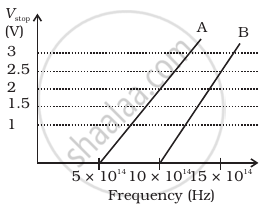Advertisements
Advertisements
Question
The wavelength of a photon needed to remove a proton from a nucleus which is bound to the nucleus with 1 MeV energy is nearly ______.
Options
1.2 nm
1.2 × 10–3 nm
1.2 × 10–6 nm
1.2 × 101 nm
Solution
The wavelength of a photon needed to remove a proton from a nucleus which is bound to the nucleus with 1 MeV energy is nearly `underline(1.2 xx 10^-3 nm)`.
Explanation:
According to Einstein’s quantum theory light propagates in the bundles (packets or quanta) of energy, each bundle is called a photon and possessing energy. Energy of photon is given by
`E = hv = (hc)/λ`; where c = Speed of light, h = Planck's constant = `6.6 xx 10^-34` J-sec, v = Frequency in Hz, λ = the minimum wavelength of the photon required to eject the proton from nucleus.
In electron volt, `E(eV) = (hc)/(eλ) = 12375/(λ(Å)) = 12400/(λ(Å))`
According to the problem,
Energy of a photon, E = 1 MeV or 106 eV
Now, hc = 1240 eV nm
Now, `E = (hc)/λ`
⇒ λ = `(hc)/E = 1240/10^6` nm
= 1.24 × 10–3 nm
APPEARS IN
RELATED QUESTIONS
In an experiment on the photoelectric effect, the slope of the cut-off voltage versus the frequency of incident light is found to be 4.12 × 10−15 Vs. Calculate the value of Planck’s constant.
Write Einstein’s photoelectric equation?
point out any two characteristic properties of photons on which Einstein’s photoelectric equation is based ?
Briefly explain the three observed features which can be explained by Einstein’s photoelectric equation.
Is p − E/c valid for electrons?
The frequency and intensity of a light source are doubled. Consider the following statements.
(A) The saturation photocurrent remains almost the same.
(B) The maximum kinetic energy of the photoelectrons is doubled.
The electric field at a point associated with a light wave is `E = (100 "Vm"^-1) sin [(3.0 xx 10^15 "s"^-1)t] sin [(6.0 xx 10^15 "s"^-1)t]`.If this light falls on a metal surface with a work function of 2.0 eV, what will be the maximum kinetic energy of the photoelectrons?
(Use h = 6.63 × 10-34J-s = 4.14 × 10-15 eV-s, c = 3 × 108 m/s and me = 9.1 × 10-31kg)
Use Einstein's photoelectric equation to show how from this graph,
(i) Threshold frequency, and
(ii) Planck's constant can be determined.
A student performs an experiment on photoelectric effect, using two materials A and B. A plot of Vstop vs ν is given in Figure.

- Which material A or B has a higher work function?
- Given the electric charge of an electron = 1.6 × 10–19 C, find the value of h obtained from the experiment for both A and B.
Comment on whether it is consistent with Einstein’s theory:
The photon emitted during the de-excitation from the first excited level to the ground state of a hydrogen atom is used to irradiate a photocathode in which the stopping potential is 5 V. Calculate the work function of the cathode used.
